Engaging families in health services research on childhood visual impairment: barriers to, and degree and nature of bias in, participation
- PMID: 15148212
- PMCID: PMC1772196
- DOI: 10.1136/bjo.2003.033258
Engaging families in health services research on childhood visual impairment: barriers to, and degree and nature of bias in, participation
Abstract
Aim: To investigate the barriers to, and degree and nature of bias in, participation in health services research by parents of children with visual impairment.
Methods: Parents of children newly diagnosed with ophthalmic disorders at Great Ormond Street Hospital, London, participated in a study to elicit their health service experiences and needs through a postal questionnaire survey followed by in-depth interviews. The participating and non-participating families were compared at different stages of recruitment, according to sociodemographic and clinical characteristics.
Results: 20% (55) of all eligible families could not be invited to participate because of out of date contact details for either the family and/or family doctor in the hospital and/or community record systems. Completed questionnaires were received from 67% (147/221) of contacted families, although only 6% actively declined to take part. Compared to non-participating parents, those who took part were more likely to be white British, from higher socioeconomic groups, have English as their main language, and have no other visually impaired family members. There were no significant differences according to the clinical characteristics of their affected children.
Conclusions: Families from socioeconomically deprived and ethnic minority groups are likely to be less visible than others in health services research on childhood visual impairment. Geographical mobility in families of young children with visual disability poses a potentially important obstacle to engaging them in research on their experiences of health services. These findings indicate the importance of addressing potential biases in the design and interpretation of future studies, to ensure equity in recommendations for policy and practice, and in implementation of services.
Figures
Comment in
-
Childhood vision impairment.Br J Ophthalmol. 2004 Jun;88(6):728-9. doi: 10.1136/bjo.2003.040006. Br J Ophthalmol. 2004. PMID: 15148200 Free PMC article. No abstract available.
References
-
- Bent N, Tennant A, Swift T, et al. Team approach versus ad hoc health services for young people with physical disabilities: retrospective cohort study. Lancet 2002;360:1280–6. - PubMed
-
- Read J. Disability, the Family and Society. Listening to mothers. 1st ed. Milton Keynes: Open University Press, 2000.
Publication types
MeSH terms
LinkOut - more resources
Full Text Sources
Medical


